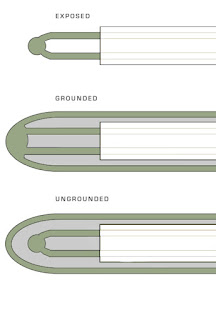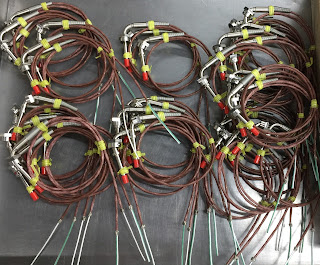This post explains the basic operation of the three most common temperature sensing elements -
thermocouples,
RTD's and thermistors.
A thermocouple is a temperature sensor that produces a micro-voltage from a phenomena called the Seebeck Effect. In simple terms, when the junction of two different (dissimilar) metals varies in temperature from a second junction (called the reference junction), a voltage is produced. When the reference junction temperature is known and maintained, the voltage produced by the sensing junction can be measured and directly applied to the change in the sensing junctions' temperature.
Thermocouples are widely used for industrial and commercial temperate control because they are inexpensive, fairly accurate, have a fairly linear temperature-to-signal output curve, come in many “types” (different metal alloys) for many different temperature ranges, and are easily interchangeable. They require no external power to work and can be used in continuous temperature measurement applications from -185 Deg. Celsius (Type T) up to 1700 Deg. Celsius (Type B).
Common application for thermocouples are industrial processes, the plastics industry, kilns, boilers, steel making, power generation, gas turbine exhaust and diesel engines, They also have many consumer uses such as temperature sensors in thermostats and flame sensors, and for consumer cooking and heating equipment.
RTD’s (resistance temperature detectors), are temperature sensors that measure a change in resistance as the temperature of the RTD changes. They are normally designed as a fine wire coiled around a bobbin (made of glass or ceramic), and inserted into a protective sheath. The can also be manufactured as a thin-film element with the pure metal deposited on a ceramic base much like a circuit on a circuit board.
The RTD wire is usually a pure metal such as platinum, nickel or copper because these metals have a predictable change in resistance as the temperature changes. RTD’s offer considerably higher accuracy and repeatability than thermocouples and can be used up to 600 Deg. Celsius. They are most often used in biomedical applications, semiconductor processing and industrial applications where accuracy is important. Because they are made of pure metals, they tend to more costly than thermocouples. RTD’s do need to be supplied an excitation voltage from the control circuitry as well.
The third most common temperature sensor is the thermistor. Thermistors work similarly to RTD’s in that they are a resistance measuring device, but instead of using pure metal, thermistors use a very inexpensive polymer or ceramic material as the element. The practical application difference between thermistors and RTD’s is the resistance curve of thermistors is very non-linear, making them useful only over a narrow temperature range.
Thermistors however are very inexpensive and have a very fast response. They also come in two varieties, positive temperature coefficient (PTC - resistance increases with increasing temperature), and negative temperature coefficient (NTC - resistance decreases with increasing temperature). Thermistors are used widely in monitoring temperature of circuit boards, digital thermostats, food processing, and consumer appliances.
For more information,
contact Duro-Sense by calling 310-533-6877 or visit
https://duro-sense.com.









